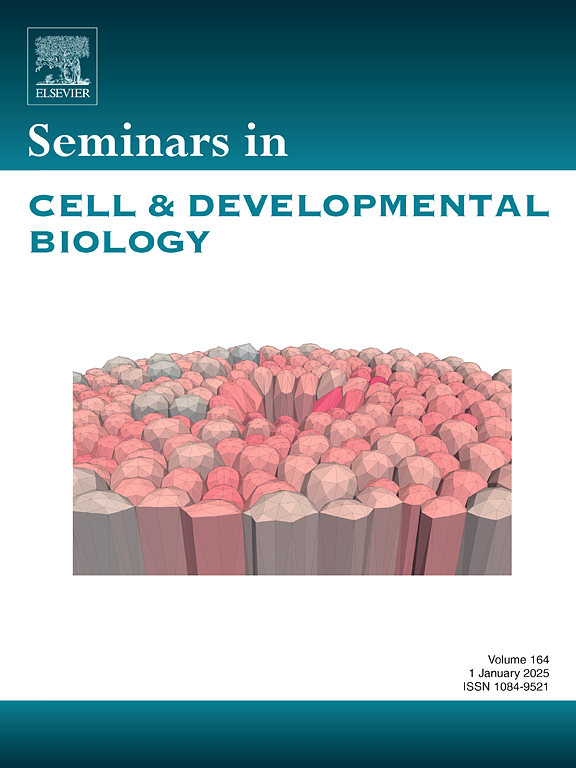绘制心脏景观:心脏生物学的空间转录组学进展
IF 6
2区 生物学
Q1 CELL BIOLOGY
引用次数: 0
摘要
心脏是胚胎发育过程中最先形成的器官。在整个发育过程中,它继续生长并发挥作用,通过将营养物质循环到所有发育中的器官来支持成熟的胎儿。心脏细胞空间组织的缺陷可导致先天性心脏缺陷(CHD),影响所有活产婴儿的1-3 - %,以及成人心脏病。空间转录组学通过提供完整组织内基因表达的高分辨率图谱,为整个心脏的细胞相互作用和空间组织提供了见解,彻底改变了我们对心脏生物学的理解。最近的改进已经能够精确绘制人类心脏发育中的细胞异质性,揭示心肌细胞和非心肌细胞的空间组织群体以及心脏形态发生中的关键信号通路。使用这些技术对心肌梗死后成人心脏的研究揭示了损伤区特异性的基因表达模式。此外,将空间转录组学与表观遗传学、蛋白质组学和功能数据相结合的多模式方法扩大了我们对细胞类型特异性反应和支持心脏损伤反应和纤维化的分子机制的理解。在这里,我们描述了目前可用的空间转录组学技术的范围,并讨论了进行空间分析所涉及的技术考虑。我们进一步强调了从早期空间制图技术到当代高分辨率、多模态方法在心脏组织研究中的进展,强调了这些进步如何为心脏发育、疾病和再生提供前所未有的见解,并讨论了应用空间转录组学解决心血管生物学和治疗基本问题的未来方向。本文章由计算机程序翻译,如有差异,请以英文原文为准。
Charting the cardiac landscape: Advances in spatial transcriptomics for heart biology
The heart is the first organ to form in the developing embryo. Throughout development, it continues to grow and function to support the maturing fetus by circulating nutrients to all of the developing organs. Defects in the spatial organization of cardiac cells can lead to congenital heart defects (CHD), which affects 1–3 % of all live births, as well as adult heart diseases. Spatial transcriptomics has revolutionized our understanding of cardiac biology by providing high-resolution maps of gene expression within intact tissue, offering insights into cellular interactions and spatial organization across the entire heart. Recent improvements have enabled precise mapping of cellular heterogeneity within developing human hearts, revealing spatially organized populations of cardiomyocytes and non-cardiomyocyte cells and key signaling pathways in cardiac morphogenesis. Studies of adult hearts post-myocardial infarction (MI) using these technologies have unraveled gene expression patterns specific to injury zones. Furthermore, multi-modal approaches combining spatial transcriptomics with epigenetic, proteomic, and functional data have expanded our understanding of cell type-specific responses and molecular mechanisms underpinning cardiac injury responses and fibrosis. Here, we describe the range of spatial transcriptomic technologies currently available and discuss the technical considerations involved in conducting spatial analyses. We further highlight the progression from early spatial mapping techniques to contemporary high-resolution, multi-modal approaches in studying cardiac tissue, underscoring how these advancements provide unprecedented insights into heart development, disease, and regeneration, and discuss future directions for applying spatial transcriptomics to address fundamental questions in cardiovascular biology and therapy.
求助全文
通过发布文献求助,成功后即可免费获取论文全文。
去求助
来源期刊
CiteScore
15.10
自引率
1.40%
发文量
310
审稿时长
9.1 weeks
期刊介绍:
Seminars in Cell and Developmental Biology is a review journal dedicated to keeping scientists informed of developments in the field of molecular cell and developmental biology, on a topic by topic basis. Each issue is thematic in approach, devoted to an important topic of interest to cell and developmental biologists, focusing on the latest advances and their specific implications.
The aim of each issue is to provide a coordinated, readable, and lively review of a selected area, published rapidly to ensure currency.

 求助内容:
求助内容: 应助结果提醒方式:
应助结果提醒方式:


